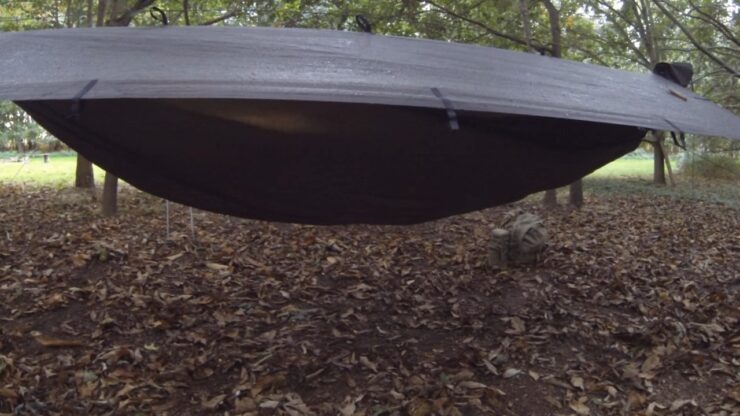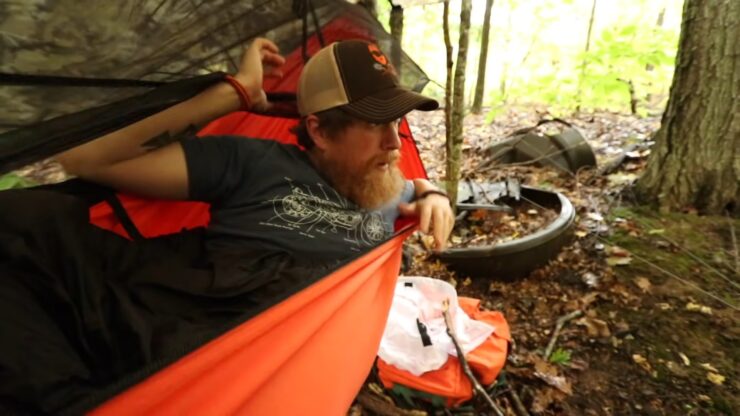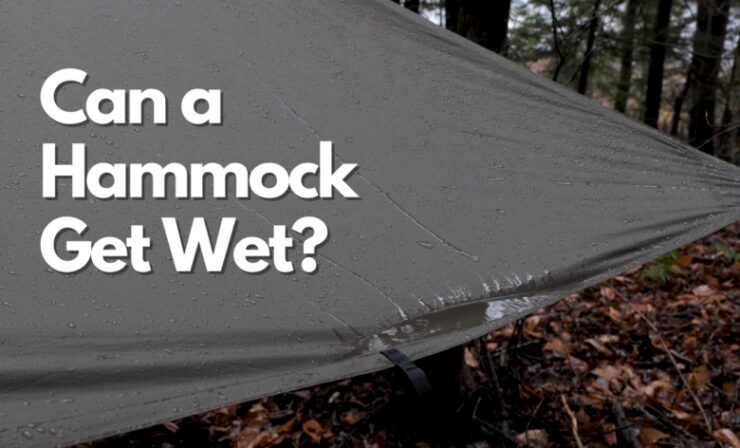When camping, keeping your gear dry is always one of the top priorities, but unfortunately, accidents do happen. Can a hammock get wet? What do you do with a wet hammock? How can I keep my hammock dry? We’ve done the research and have you covered here at Hammockinformation.com
To answer the question; yes, most hammocks are able to get wet; however, they must be dried out properly afterward. The biggest issue with water and hammocks isn’t so much the fact that the hammock got wet, but that it was stored improperly afterward and grew mold and mildew. This can be prevented by properly taking care of your hammock.
Contents
How to Dry out A Wet Hammock

It’s easy to take care of your hammock after it gets wet. The key is to air it out; that’s it. This means if you have a camping hammock, do not stuff it back in its stuff sack for a long period of time. Storing it wet will allow mildew and mold to start to grow.
Even if you are able to save it from permanent damage, the hammock may take on a smell that can be hard to get rid of. I would not recommend leaving it in its stuff sack even just overnight.
The easiest way to air it out is to set it up. You can do this outside or even in your house; I like to do it outside because I like the freshness of it. You don’t have to set it up properly if you aren’t going to use it. Heck, you can even set it up upside down, as long as it isn’t balled up. If you are able to spread the hammock out, you should do so.
Once the Hammock is dry, you are all done. You can stuff it back its stuff sack and store it away. This isn’t just true for just camping hammocks. If you have a cotton or rope hammock, you should always dry it and air it out before storing it for any amount of time.
Can Your Put Your Hammock In the Dryer?
I do not recommend that you put your camping hammock in the dryer and most manufacturers don’t either. Although some people have reported success drying nylon hammocks on low heat, you are still putting your hammock at risk of being damaged. If you do decide to dry your camping hammock, make sure you do not use high heat as this could ruin your it for good.
Rope hammocks are one style of hammock that can be washed in the dryer. This is not applicable for models that use a spreader bar; if you put one of those in the dryer you are likely to have both a wet hammock and a broken dryer. Just make sure that your machine is able to handle the weight of the waterlogged hammock before you dry it.
I think that playing it safe and hanging your hammock to dry is the best solution. It takes roughly 30 minutes, which is about the same time a dryer would take, and there is no risk involved. Hanging your hammock is still less work than taking down, and drying a tent. If you are still unsure how you should dry your hammock, check your hammock manufacturer’s website and follow their cleaning directions.
How to Remove The Mildew Smell
Just because you know how to dry a hammock doesn’t mean that you will always be able to do so immediately after it gets wet. Maybe you had you to leave your hammock in the car, or maybe it rained all night and you had no place inside to hang it. If you take your hammock out and it smells like mildew; don’t worry, you can probably save it.
A little bit of mildew isn’t a big problem, but it might take more than a spray to clean it. If you can see it, you should scrub it off, and then wash your hammock with soap and water, then hang it to dry. It’s that simple really. This should have your hammock smelling fresh as soon as it drys.
Because mildew is a fungus you want to make sure that you aren’t breathing it in. Although some people come in contact with mildew on a regular basis, it can still cause problems. I also suggest using gloves, especially if you are using a heavier cleaning agent. Remember to check with the manufacturer to clean your hammock properly.
What if Your Hammock gets Moldy
If your hammock has gotten damp to the point where there is mold is growing on it, I suggest buying (or making) a new hammock. If the problem is not too severe you may be able to clean it off the same way you clean off mildew, but I suggest just replacing it. It is very important to make sure your that your hammock is mold free before sleeping in it.
Leaving a Hammock Outside

I always have people ask if they should leave their hammock outside when they aren’t using it. It’s convenient to just walk out to your front yard and lay in your hammock. Personally, I think that it’s almost as easy to walk up, clip in your suspension, and then lay down.
I recommend taking your hammock inside overnight and when it’s raining. I say this because not only are most hammocks easy to set up but bringing them in also saves them from damage. What you should do is; leave the suspension on either the hammock or the anchors, then all that you have to do is clip it in and lie down. It’s so easy to keep your hammock dry this way.
Cotton Hammocks that don’t use a suspension, but instead stretch up over the stand, are more difficult to set up before every use, but I still think you should bring them inside. There are hammocks that are alright to leave outside and I have even seen some made out of plastic materials that don’t become waterlogged. If you are unsure if your hammock should be left outside for extended periods of time I suggest contacting the manufacturer of your hammock.
How to Keep Your Camping Hammock Dry
I know that it might be impossible to keep your hammock dry, especially when you are camping and a starry night turns into a stormy one without any warning. Here are a few tips that you can use to try and keep your hammock dry.
- Keep your Hammock in a Dry Bag– Dry bags are an inexpensive, yet effective method of keeping any piece of gear you own dry. If you are serious about camping then you probably own a few of these already.
- Use a Tarp- Even if it’s not supposed to rain it’s a good idea to use a tarp for shelter. Surprises happen. The longer the tarp, the more of an angle it will cover. Sometimes it’s not just the rain that gets your hammock wet but the dew!
- Know Where it is in Your Pack- A person who packs with purpose is always more prepared. It’s always a good idea to pack things that you don’t want to get wet in the center of your pack. That way if it rains, or if you fall in a puddle, it won’t get soaked.
The Takeaway
The takeaway is this; if your hammock gets wet, there is no need to freak out. Most hammocks can easily be dried by hanging up for around 30 minutes. I suggest doing this outside, but you can hang it inside too. There are even some hammocks, like rope hammocks (without spreaders) that you can throw in the dryer.
If your hammock gets wet and begins to smell you can always clean it. If it gets moldy or smells of mildew, you can try and clean it but it may need to be replaced. Remember to take care to not breathe any of the molds in. Consult your hammock manufacturer for the best cleaning recommendations for the one you own.
The best thing to do is to try and be proactive by not letting your hammock get wet. You can do this with lawn hammocks by taking them inside when you are not using them. When it comes to camping hammocks there are some things you can try, but the risk of it getting wet is always present.
Just remember to try and take care of your hammock when it gets wet. Especially if you want it to last you a long time.
References:
https://www.themanual.com/outdoors/tips-for-camping-in-the-rain/


